Create PDF files from any Navision
Attention! These instructions are OUTDATED! Since Windows 10, there is a suitable printer driver directly in the operating system. This is a little slower (really!) than the solution described here, but it doesn't require any more tricks. You can find the corresponding installation instructions here. Wenn Sie aber XP oder Windows 98 oder Windows Server 2003 oder ähnliche Betriebsysteme haben, damit Sie Navision 2.60, Navision Financials 2.01, 3.70 etc weiter betreiben können, brauchen Sie zwingend noch den Ghostscript-PDF Druckertreiber! Scrollen Sie bitte weiter bis nach unten, dort finden Sie die nötige Anleitung. Für Windows 10, Windows 11, Windows Server 2023 etc. finden Sie die Anleitung ab hier.
With Ghostscript you can create PDF files directly from Navision. This mainly applies to older Navision versions from 3.53 to 3.56 (DOS versions) via Navision 2.01 to 2009R2. Navision RTC can automatically output every report as a PDF.
However, you need a printer driver that also generates clean Postscript (the basic language of PDF). Preferably also one that can output color and large formats such as A3, then you have everything done in one fell swoop.
Für die Navision-Versionen unter 4.03 (also 2.01, die DOS-Versionen, Navision 2.60, Navision Financials 3.70 etc. ist diese Anleitung hier noch immer die erste Wahl, da diese Navision nicht unter Windows 11 respektive Windows Server 2023 laufen.
Printing, mailing & faxing from Navision - all together with our tools for the native Navision versions and Ghostscript.
Note: Once Ghostscript has been set up, you can of course also split PDF documents into individual pages, combine individual PDF pages in any order to create new PDF documents, combine background pages with foreground pages and much more. And: You can control the whole thing in Navision, e.g. to generate catalog documents even more easily.
Replacement for Adobe Universal Postscript Printerdriver
In the past, the Adobe Universal PostScript Windows Driver could be used for the following Postscript printer driver. Which in fact was not a printer driver at all, but simply a small exe file which (as in this manual) registered the Microsoft Postscript (PSCRIPT5 or PSCRIPT.OEM) driver under a new name. This setup was only intended for Windows 95, 08, Nt 2000 and so on, and has since been completely discontinued by Adobe.
Einrichten des nötigen PDF Postscript Druckertreibers unter Windows 10 etc.
Setting up the Postscript printer driver:
Press CTRL+ESC: The Windows start menu opens. Now simply type the three letters P R I on the keyboard and Windows will suggest "Printers & Scanners". Click on "Printer & Scanner":
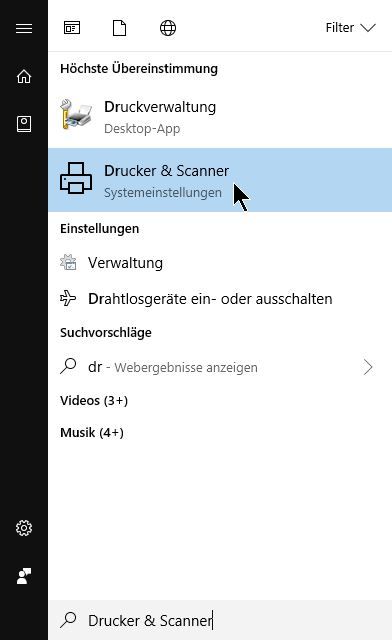
In the dialog that opens, first click on "Add printer & scanner". Windows builds up the printer list. After a few seconds, the additional text "The desired printer is not listed" appears. Please click on this:
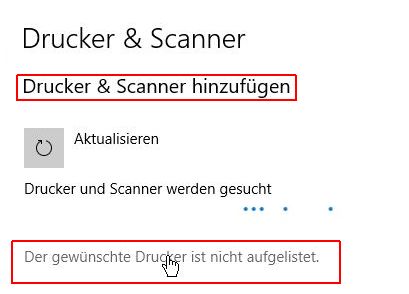
In the following dialog, select the lower option "Add local printer or network printer with manual settings", then "Next":
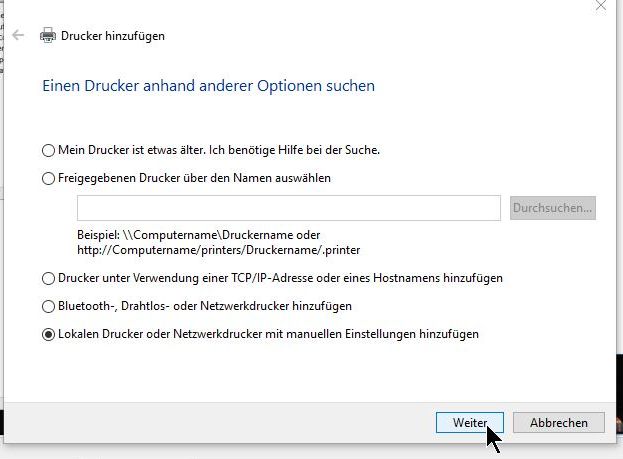
Now select "Create new port", enter "Local Port" as the option, then "Next":
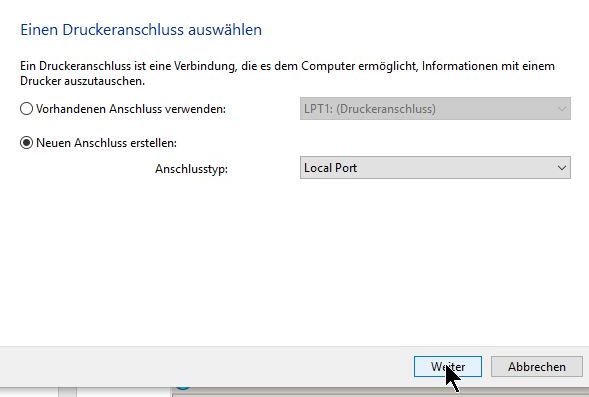
Windows then asks for the output destination:

(of course, the folder c:\temp must also exist for this!)
The driver should be as universal a Postscript printer driver as possible, the HP Color 5550 Class Driver PS included in the standard Windows is NO longer an alternative! The important "print directly to port" cannot be configured here as this is an XPS driver. However, XPS requires the use of the print spooler.
New recommendation: Manufacturer Generic, printer C MF310P-1 PS. You can find it via "Windows Update":
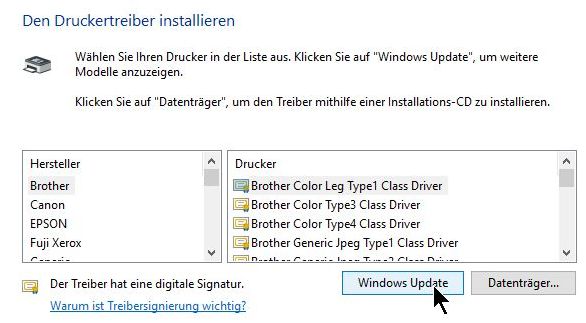
This process "The printer list is being updated" will take several minutes, 15 minutes has already been experienced. You must wait for this time, the process cannot be accelerated. Then select "Generic" on the left under Manufacturer, then Printer C MF310P-1 PS on the right:

Attention! The selection of both internal printers and printers accessible via Windows Update changes constantly.
Here are some rules of thumb for a usable printer driver (it all depends on the driver!):
- The name does NOT contain XPS or GDI
- The name contains c or color
- The printer model can print A3 .
Apart from the first point, a simpler printer can of course also be selected depending on the application. Other alternatives: Epson EPSON AL-C8500 PS3, HP Color LaserJet 2800 Series PS.
Click "Next".
Change the printer name to NavisionPS:

Do NOT share the printer and CONTINUE. If Windows gives you the message "The printer driver has NOT been installed", simply try again and it will usually work. The error was then simply a problem downloading the driver from Microsoft, e.g. due to a weak or overloaded Internet connection.
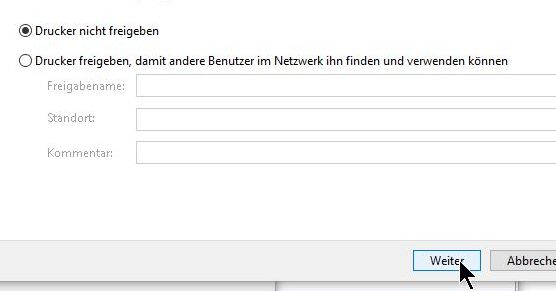

Set as default printer is do not necessary nor useful.
The printer spooler must still be switched off.
Click on Printer/Manage/Printer Properties/Advanced:
Select "Print directly to connection".

If the option is grayed out, there are several possibilities:
- You do not have permission to change printer settings. If you have carried out the steps up to this point, this is not possible.
- The printer is a network printer.
If you have carried out the steps up to this point, this is not possible. - The printer driver is an XPS (XML Paper Specification, a planned replacement from Microsoft for the PDF format) driver. This is absolutely dependent on the spooler; printing directly is therefore generally not possible..
- The printer driver is a rather old and/or cheap GDI (GDI explanation) printer. This is also dependent on the spooler service, among other things.

If "route print jobs directly to the printer" simply doesn't work...
Extra tip: If the printer driver recommended above scales incorrectly, for example, you can replace it AFTER this installation with the original Microsoft PS driver. AFTER is important because you cannot set the option "Route print jobs directly to the printer" with the Microsoft driver. Funnily enough, however, Windows adopts the previously set setting from the recommended PS driver without any problems:

Installieren des Windows XP PDF Ghostscript Postscript Drucker Treibers
xRechnung hat es wieder nötig gemacht! Es gibt noch immer zahlreiche 2.01er (auch technisch!), 2.60er, 3er Navision Financials da draußen… Und auch sie müssen ja xRechnungen / eRechnungen ausstellen können.
Das ist auch erst einmal gar nicht so tragisch, da meine Lösung ja sowieso „Nur“ UBL in XML als Dateianhang an die Mails mit der eh schon „ewig“ generierten PDF Rechnungsmail erstellt. Und doch, es ward da eine Zeit, in der tatsächlich auch Anwender dieser etwas in die Tage gekommenen Navision Financial Versionen noch keine PDF Rechnungen ausgeben… und das im 21. Jahrhundert. Hier und da hat da auch mal ein Händler wohl gesagt „Das geht mit diesem alten Navision nicht mehr, Sie müssen ein neues kaufen.
Das ist -in dieser Form- Quatsch. Es gibt immer noch Soll und Haben, Artikel haben immer noch Bestände und Sonderpreise… Eine Warenwirtschaft ist halt kein Grafikkartentreiber, welcher erstens voll mit Fehlern und zweitens nur mit regelmässigen Updates lauffähig ist. Navision Financials 2.01 war eine der stabilsten Versionen, die je auf den Markt kamen, und (zusammen mit 2009 R2) auch eine der am leichtesten und am schnellsten programmierbaren Versionen.
Und: Natürlich können diese auch PDF ausgeben! Insbesondere z.B. im Zusammenhang mit meiner xRechnungslösung ist dies die „Rundherum Sorglos“ Lösung.
Übrigens: Müssen Sie eine ältere Navision Version auf einer Virtuellen Umgebung wie XP installieren, oder mit z.B. Navision Financials 4.03, Navision 2005 oder 2009 brandneu auf einem SQL Server installieren? Hier finden Sie viele Handreichungen für diese Älteren (aber nicht alten!) Navision Financials Lösungen.
Starten Sie das Startmenü mit Strg+ESC oder einen Klick auf „Start“:

Klicken Sie auf „Drucker hinzufügen, dann auf „Weiter“

Nehmen Sie bitte folgende Einstellungen vor (Der Anschlussname ist „c:\temp\NavPdf\Navision.ps“) (denken Sie bitte daran, vorher auf Laufwerk C: sowohl den Ordner Temp wie auch den darin enthaltenen Unterorder NavPdf azulegen!) und drücken Sie dann auf „Weiter“

Wählen Sie hier nun z.B. den Hersteller „Apple“ und den Drucker „Apple LaserWriter 16/600 PS“ aus, dann „Weiter“. Ändern Sie den Druckernamen bitte auf „NavisionPS“ (ohne Punkte oder Anführungstriche), dann Weiter, dann „Drucker nicht freigeben“, dann Weiter, Dann Ja (Testseite drucken), dann Weiter, dann fertig stellen.
Sie können auch einen wirklich guten PCL Druckertreiber direkt von Ghostscript laden, Sie finden diesen Hier: https://ghostscript.com/releases/gpcldnld.html, drücken Sie dann den link zu GhostPCL AGPL Release neben der 32Bit PCL version.
Bestätigen Sie bitte die Rückmeldung, das eine Testseite gedruckt wurde, und prüfen Sie bitte, ob diese Testseite in c:\temp\NavPdf unter dem Namen Navision.ps angelegt wurde. Drücken Sie OK.

Außerdem müssen Sie Ghostscript installieren, gehen Sie dafür bitte wie folgt vor:
laden Sie sich die 32Bit (!!!) Version von Ghostscript herunter, z.B. von hier: https://ghostscript.com/releases/gsdnld.html

Ich empfehle Ihnen dringend, diese Downloads do not mit dem XP Client durchzuführen!! Wenn Sie Probleme haben, die heruntergeladenen Druckerdateien in die XP Sitzung zu bekommen, schauen Sie bitte hier nach.
Installieren Sie dann das Ghostscript im Ordner „C:\Programme\gs“. Ich empfehle hier do not den vorgeschlagenen Pfad zu verwenden, weil Sie dann bei jedem Update den Pfad auch in Navision Financials ändern müssen.
Dies war’s, der Rest wird von Navision gesteuert. Happy PDF Erstellung!

